Pies are widely popular all over Russia, but each region has its own national kinds of pies. In this context, this stuffed pastry can be regarded as the national cultural treasure and also as a token of homeliness and family comfort.
Pies Everywhere
Pies are popular for a very good reason. You don’t need utensils to bake them because the dough acts as a dish for the filling. Therefore pies are great to take along while travelling or when working in the field. At the same time, in different cultures, pies are a ceremonial, sacred meal. People cook pies for weddings and funerals, name days and christenings. For example, the Ossetians have a well-known rite of Three pies, when thin pies with cheese filling are stacked on top of each other to symbolize the threefold model of the world (God, Sun, Earth). The funerals feature only two pies because the sun no longer shines on the deceased. In Russia, a pie with wheat grains in it was broken over the newlyweds at the wedding table — it was believed that the more grains pour out of the pie, the more prosperous the newlyweds would become.
Pastry with National Identity
Pies are often mentioned in Russian fairy tales and proverbs, so we can assume that they were a regular meal used to measure the wealth and hospitality of the hosts. Some of the names such as “gubniki,” “vekoshniki,” or “borkanniki” have become obsolete. Other pies still exist, allowing one to literally taste
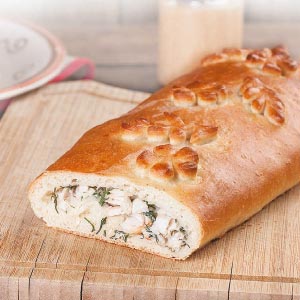
the history. Among them, there are traditional Russian pies kurnik, kulebyaka, and rasstegai. Kurnik is called the king of pies, and it even resembles the famous Crown of Monomakh. It has two types of dough in it: one goes to the outer crust, and another is used to make thin “crepes” between layers of filling. Kurnik has at least three layers filled with rice, eggs with fried onions, mushrooms, sauerkraut, various types of meat. The fillings are thick, so the kurnik is often the main decoration of the festive table, rising like a tsar above other meals.
Kulebyaka is made according to the same layer-by-layer principle. However, fillings are often placed not in layers but in sectors at the corners, so the pie can have two, three, or four corners. A properly baked kulebyaka is toasted on top and soaked
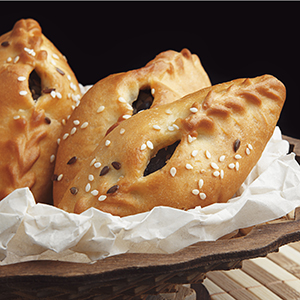
with juice from the filling at the bottom. Perhaps, the most colorful description of this dish can be found in Anton Chekhov’s story Siren: “The kulebyaka should be appetizing, shameless in all its nakedness, so that there is temptation. You wink at her, cut off a huge piece, and move your fingers over her like that, out of abundance of heart. And when you eat it, butter dropping like tears, its filling fat, juicy, with eggs, with giblets, with onions…”
Only rasstegai could rival the kulebyaka in popularity. It is a pie with an open middle through which one can see fish, meat, or mushroom filling. In Russian taverns of the 19th century, rasstegai were often served like bread for meals like fish soup and broth. If rasstegai was served as the main dish, one would pour a spoonful of strong broth inside before

serving.
The Volga region with its vast fertile lands always had plenty of flour. Therefore, the Tatar, Chuvash, and Bashkir cuisine has a number of pastry recipes. During festivities or when awaiting guests, the local women baked gubadiya — a tall round pie made of sweet, usually nonfermented dough with 5–7 layers of fillings: rice, cottage cheese, chopped, eggs and various dried fruits.
Another famous examples of the Volga cuisine are echpochmak and belyash. Echpochmak is a triangular pie made of nonfermented dough with potatoes, meat, and onions. A proper echpochmak must have a hole in the middle where you can pour hot broth — this is how these pies were eaten by the Turkic nomads who invented this famous
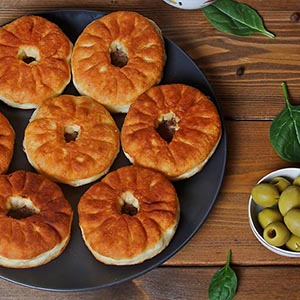
recipe. Belyash is an open pie which can be made of fermented or nonfermented dough with minced meat and fried in oil. The dough should be thin, with juicy filling and slightly toasted crust. Interestingly, belyash was extremely popular during the Soviet times when they were sold in all buffets, but often with pork filling that simply could not exist in the original recipe.
In the mountainous regions of Russia, people usually make flatbread instead of pies, so the Ossetian pie is a delicious exception to the general rule.
Ossetians are descendants of nomads, and they inherited the pie recipe from their ancestors. The nomadic tribes had little flour at their disposal but more than enough meat, rennet cheese, and herbs.
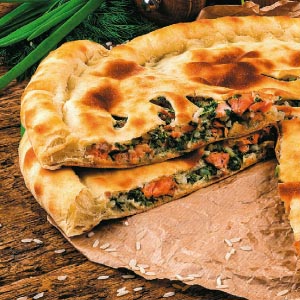
That’s why the filling makes up two thirds of the Ossetian pie, while the dough is rolled out very thin. Ossetian pie can have various fillings: beet tops, cheese, cabbage, finely chopped meat, pumpkin, mushrooms. Modern-day Ossetian pies are part of the contemporary street food, they are popular far beyond the borders of Ossetia.
The cuisine of the Russian North also includes pies. Wheat does not grow well in the harsh northern climate, so Karelian, Arkhangelsk, Vologda pastries are often made of rye flour, and pies are usually open to save dough. The recipe for the traditional open kalitka pie is simple: the dough is kneaded from rye flour, water, soured milk or sour cream, water, and salt. The pie is filled with peeled barley soaked in soured milk with melted butter. The taste of rye flour is too rough for modern-day gourmets, and the taste of peeled barley is far
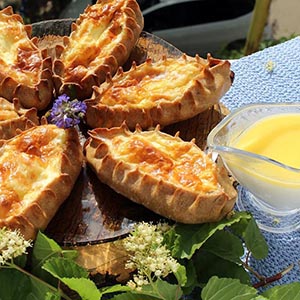
from delicate, so now kalitka pies are normally baked from a mixture of wheat and rye flour, usually with mashed potatoes inside. First, you roll out the dough for kalitka in small circles, then place the filling in the center, and pinch the edges together, so that they barely cover the filling. Ready-made kalitkas are buttered as soon as they come out of the oven.
Shanga is another pie variety from the Russian North. They are the traditional meal in the vast territory stretching from the White Sea to the Ob river. When making these pies, you simply put the filling on top of dough, without covering it.
Shangas used to be filled with pease porridge or peeled barley with butter, but now they are usually served with mashed potatoes or mashed cottage cheese.
The mighty rivers of the Russian North have always been rich
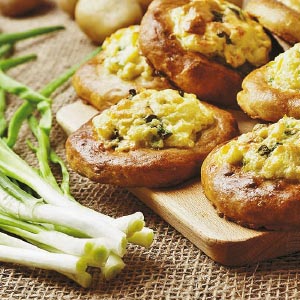
in fish, so fish pies are an important part of the local cuisine. For example, cherinyan is a traditional pie of the Komi-Zyryan people. It is made of yeast dough kneaded from a mixture of wheat and rye flour. Then, a whole gutted fish is put on top of the rolled dough, and the edges are lifted up and slightly pinched, leaving the filling half-open. In this case, the dough serves to roles at once — a baking mold and a side dish for the fish. Modern versions of cherinyan also use fish fillet as a filling.
Pies are a universal phenomenon. They were born in the times when people used swords and plow and remain popular in the days of the internet and gadgets. In essence, pies are a treasure of national culture, even though one can buy them in any café.
Tatiana Borisova

